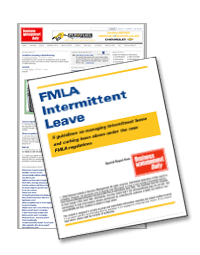By Eric B. Meyer
Neither snow nor rain nor heat nor gloom of night stays these couriers from the swift completion of their appointed rounds.
But, if you send Family and Medical Leave Act paperwork to an employee by first class mail, then you’re asking for trouble.
Did you read the headline and think to yourself, “FMLA notice? You mean there’s a notice? You mean, like in our handbook, right?”
Ah, newbie. There’s still hope for you. I have a FMLA PowerPoint. Just email me and I’ll get you started on the right track. (Also, if you missed out getting my PowerPoint about religious accommodations in the workplace, then holler at me).
Getting a FMLA notification
Now, to the rest of you FMLA-savants, let me break this one off for you.
An employee calls you from a hospital room having just suffered a serious leg injury. Your employee tells you that she needs surgery and extended recovery time. You express concern, tell the employee that she should apply for short-term disability and take a leave of absence, and then you hang up.
Crap! You forgot to mention FMLA.
But, no big deal. You just first class mail the employee a letter advising her that her leave was designated as FMLA leave, and further explaining her rights under that Act. It’s all good.
Let’s assume that 12 weeks pass, the employee fails to return to work, and you terminate her employment. Let’s also assume that her back injury is not a disability under the ADA.
Does first class mailing FMLA paperwork offer an airtight defense to a subsequent FMLA interference claim?
The perils of first class mail
Well, according to yesterday’s decision by the Philadelphia-based Third U.S. Circuit Court of Appeals in Lupyan v. Corinthian Colleges, Inc., if the employee claims that she never received the FMLA paperwork in the mail, you’re going to trial.
The reason goes something like this:
- When an employer first class mails a FMLA notice/designation to the right address, “it is presumed … that it reached its destination at the regular time, and was received by the person to whom it was addressed.”
- But, without a receipt, or other proof of delivery, then the presumption of delivery is rebuttable.
- So, if the employee is all like, “I never received the FMLA paperwork,” then it’s going to be up to a jury to decide who is telling the truth.
Building a FMLA interference claim defense
Well, that sucks.
So, what does bolster a defense to a FMLA interference claim?
- Pick a method of delivery that requires a receipt/other proof of delivery with a signature, such as certified mail, overnight delivery.
- Hand-delivery at work (with a signature) is pretty good too.
- Or email, with a return email from the recipient acknowledging receipt.
But the big mistake here, other than not mentioning FMLA at the outset, was failing to communicate with the employee while she was on leave.
You need to check in from time to time
You can do that, you know. Call her up from time to time and see how she’s doing.
It’s also OK to ask when she’s going to return. And since most FMLA serious health conditions today are also ADA (Americans with Disabilities Act) disabilities, it’s good to also inquire about the need for a reasonable accommodation upon her return.
(That FMLA PowerPoint offer is open to you HR-professionals too, you know. Just email me).
This was originally published on Eric B. Meyer’s blog, The Employer Handbook.
